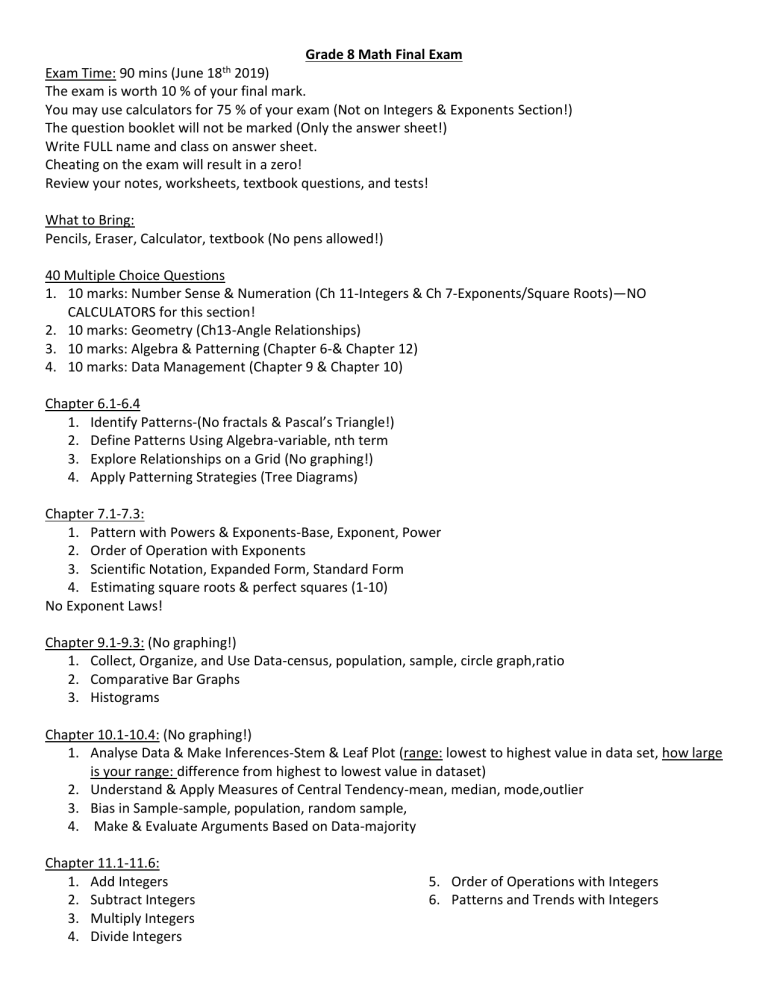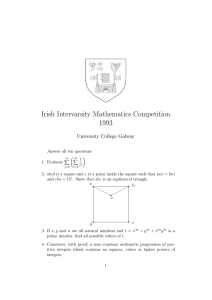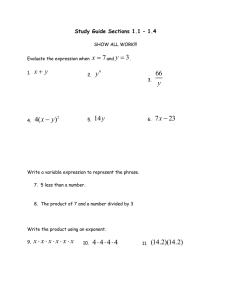
Grade 8 Math Final Exam 18th Exam Time: 90 mins (June 2019) The exam is worth 10 % of your final mark. You may use calculators for 75 % of your exam (Not on Integers & Exponents Section!) The question booklet will not be marked (Only the answer sheet!) Write FULL name and class on answer sheet. Cheating on the exam will result in a zero! Review your notes, worksheets, textbook questions, and tests! What to Bring: Pencils, Eraser, Calculator, textbook (No pens allowed!) 40 Multiple Choice Questions 1. 10 marks: Number Sense & Numeration (Ch 11-Integers & Ch 7-Exponents/Square Roots)—NO CALCULATORS for this section! 2. 10 marks: Geometry (Ch13-Angle Relationships) 3. 10 marks: Algebra & Patterning (Chapter 6-& Chapter 12) 4. 10 marks: Data Management (Chapter 9 & Chapter 10) Chapter 6.1-6.4 1. Identify Patterns-(No fractals & Pascal’s Triangle!) 2. Define Patterns Using Algebra-variable, nth term 3. Explore Relationships on a Grid (No graphing!) 4. Apply Patterning Strategies (Tree Diagrams) Chapter 7.1-7.3: 1. Pattern with Powers & Exponents-Base, Exponent, Power 2. Order of Operation with Exponents 3. Scientific Notation, Expanded Form, Standard Form 4. Estimating square roots & perfect squares (1-10) No Exponent Laws! Chapter 9.1-9.3: (No graphing!) 1. Collect, Organize, and Use Data-census, population, sample, circle graph,ratio 2. Comparative Bar Graphs 3. Histograms Chapter 10.1-10.4: (No graphing!) 1. Analyse Data & Make Inferences-Stem & Leaf Plot (range: lowest to highest value in data set, how large is your range: difference from highest to lowest value in dataset) 2. Understand & Apply Measures of Central Tendency-mean, median, mode,outlier 3. Bias in Sample-sample, population, random sample, 4. Make & Evaluate Arguments Based on Data-majority Chapter 11.1-11.6: 1. Add Integers 2. Subtract Integers 3. Multiply Integers 4. Divide Integers 5. Order of Operations with Integers 6. Patterns and Trends with Integers Chapter 12.1-12.3: 1. Model & Solve Equations-opposite operation, variable 2. Apply the Opposite Operation 3. Model Problems with Equations Chapter 13.1-13.4: 1. Types of Triangles: scalene, isosceles, equilateral triangle, right triangle, 2. Internal Angles of a Triangle (=180°) 3. Angle Properties of Intersecting and Perpendicular Lines-(opposite angles, supplementary angles, complementary angles) 4. Angle Properties of Parallel Lines (Corresponding, Alternate, Interior angles) 5. Apply Angle Measures (Triangles & Parallel/Intersecting Lines, Quadrilateral=360°) Goodluck! Review of how to create an equation (Ch 6 & 12): V = a x n (+/-) c V= term value N= term number a = If it is decreasing, number multiplied by term number will be negative If it is increasing, number multiplied by term number will positive c = If zero value is positive, the constant will be added If zero value is negative, the constant will be subtracted Eg. 1 Term Value (v): 2, 6, 10, 14 Term Number (n): 1, 2, 3, 4 1. Find the amount the term value is increasing by In Eg 1 above: It is increasing by 4 each time. a=4 2. Find the zero value (constant)When the term number is 0, the term value will be____ In Eg 1 above, zero value will be 2 - 4= -2 c= -2 3. Now put it together to create the equation: v = 4n -2 4. Test out your equation to make sure it works! In Eg 1 above, when n = 3, the value equals to 10, it works! You may use other methods if you wish as long as it works.


